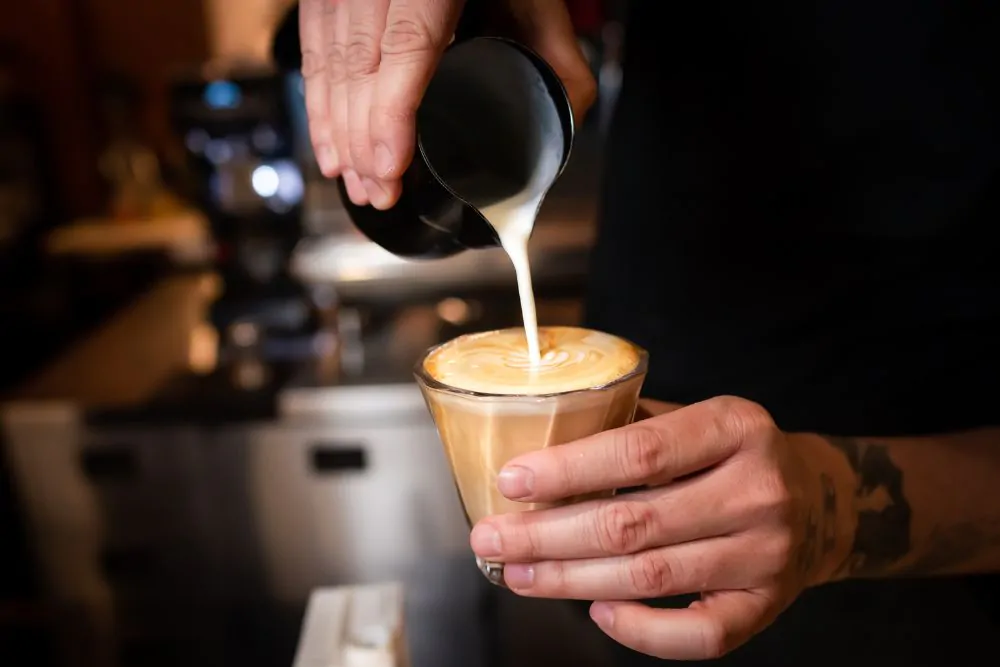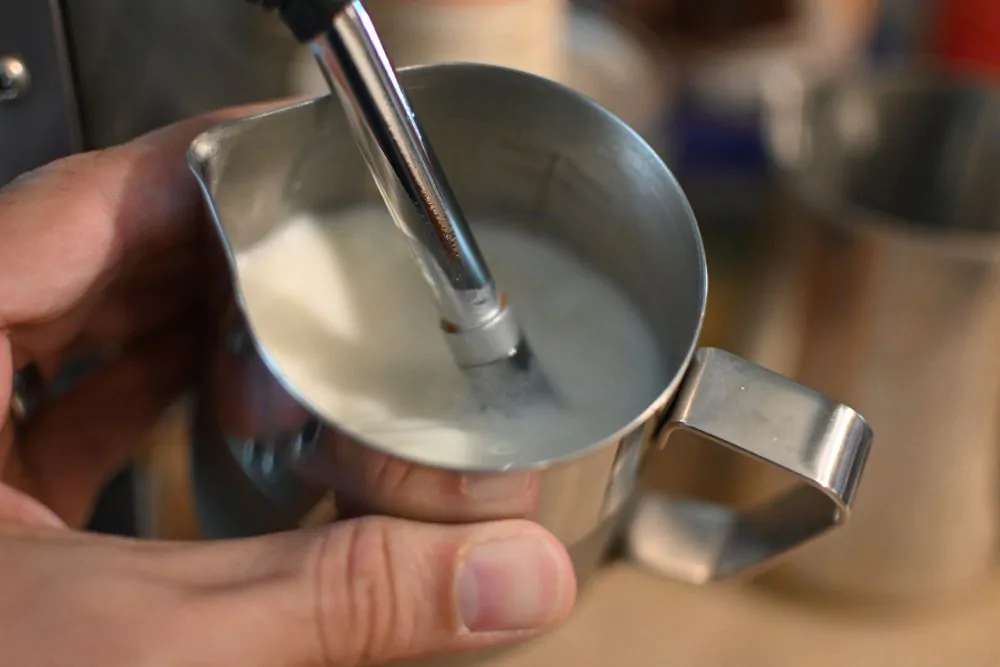At a glance, you might think a flat white and a latte are the same. Our flat white vs. latte guide will detail the differences so you can pick the best for you.

With so many options on the menu board in your local coffee shop, from cappuccino to mocha, it’s easy to get overwhelmed. In particular, many people don’t know what a flat white is. You might even wonder why so many variations of coffee with milk need to exist. That’s where we come in!
While flat whites and lattes are brewed with a shot of espresso and steamed milk, there are some key differences. One of the main distinctions is the strength of the coffee in relation to its coffee-to-milk proportion. Let’s explore these types of coffee further.
What Is A Flat White?
Flat white coffee is a small coffee beverage with less milk than a latte, so you can really taste the coffee. It’s typically five to six ounces in size and entails pouring steamed milk over an espresso shot – or two for a more potent drink.
Flat whites have a thin “flat” layer of microfoam on top, which is where it gets its name. A flat white offers a velvety, smooth texture and a strong coffee taste.
The flat white was referred to as a “small latte” before its popularity increased, and you may hear customers ask their baristas for “white coffee.” But if you don’t want to confuse your barista, simply ask for a flat white.
The term white coffee can also refer to extremely lightly roasted beans. We have got that covered as well, so if you want to find out all about white coffee, follow the link…after you have finished reading this, of course!

The flat white has a conflicting origin story. It was believed to have been created in Sydney in 1985 by Australian espresso bar owner Alan Preston. Preston made the drink in response to customers requesting a change from rich cappuccinos but still desiring that strong coffee taste.
Other reports say the drink was invented in Wellington, New Zealand, in 1989 rather than in Australia. Fraser McInnes, a barista, reportedly tried to make a cappuccino, but as he was using low-fat milk, it wouldn’t froth properly. This is why most baristas prefer to use whole milk to ensure the foamed milk comes out perfectly, as the higher fat content makes the process easier.
McInnes named the accidental creation a flat white due to its appearance.
Regardless of its origins, the new drink was an instant hit. It was brought to the U.K. in 2005 when Peter Hall, an Australian, and New Zealanders James Gurnsey and Cameron McClure opened a coffee shop called Flat White Soho in London. The flat white craze began to gain momentum in other countries and was added to the Starbucks menu in the U.S. in 2015.
What Is A Latte?
A latte is also a coffee drink made with espresso and frothed milk. You may see it referred to as café au lait or café con leche, but these are not always the exact same beverage as a traditional latte.
A latte is usually served in an eight-ounce cup, although many cafés offer bigger options. Most coffee shops use a double shot of espresso by default.
Although you could technically add flavored syrup to a flat white, people seldom do as the drink is about appreciating the robust espresso taste. Instead, baristas like to get creative with lattes and infuse all sorts of flavors, from the classic caramel or vanilla latte to seasonal pumpkin spice lattes; the options are endless. You can even enjoy iced lattes on hot summer days.
A latte has a much more milky taste than a flat white. Lattes also have a deeper foam layer on top, giving them a fluffy texture.
The latte originated in Italy. In fact, latte is the Italian word for milk, so caffè latte literally means coffee milk.
Although the exact origins of the latte are lost to time, the first record of it is believed to have come from 1867. The coffee drink was mentioned in William Dean Howell’s essay, Italian Journeys, where he was served a drink of coffee and milk with breakfast during his trip. However, this drink was not like the lattes we know and love today, as the espresso machine had not been invented yet.
Espresso also originated in Italy, with Angelo Moriondo getting a patent for a machine that brewed coffee with stream in 1885. Then in the early 1900s, Luigi Bezzera invented what is more reminiscent of a modern espresso machine.
Flat White Vs. Latte: The Differences
One of the main differences between a latte and a flat white is the amount of coffee they use compared to the milk. Generally, a latte has one part espresso to three parts milk. In contrast, there is usually one part espresso to two parks milk in a flat white.
As mentioned earlier, the flat white got its name from the tiny layer of foam on top, while a latte will have a more substantial foam layer but still much less than a cappuccino.
For this reason, the intense coffee flavors in a flat white will shine through, with the milk softening the blow. It’s been described as tasting like a creamy espresso with a soft mouthfeel. Both drinks have a smooth, velvety texture, but the latte is creamier as the espresso is more diluted.

When steaming the milk for a flat white, the barista will pay attention to how the milk rises in the jug. Once the milk expands, they put the steam wand under the milk to reduce the amount of foam forming.
In contrast, the barista will hover the milk frothing wand around the surface to create foam for a latte – and even more so for a cappuccino.
A flat white will usually be six ounces in size. Some coffee chains will offer bigger servings, but unless they maintain the coffee-to-milk ratio, it may not be an authentic flat white with increased milk.
A latte tends to start at eight ounces but can go up to 12 or 16 ounces if you want a bigger drink. Remember that the amount of espresso shots may be altered to maintain the balance of flavors.
As there’s more foam on a latte, creative baristas love to draw latte art. Although this doesn’t alter the taste, it’s a nice touch, and a good design is sure to be popular on Instagram among coffee lovers. Expert baristas will also make latte art on flat whites.
Flat whites and lattes are both excellent drinks. The flat white is ideal for those who want a small but strong drink to perk them up in the morning without having to down a bitter espresso shot.
Alternatively, a latte offers a mild, slow cup of Joe. It will still perk you up, but you won’t notice the espresso taste as much. Plus, since you can go for iced options or add any flavored syrup you can dream of, the latte is the perfect introduction to the coffee world for newcomers.
We have many articles comparing coffee drinks to help you explore the coffee shop menu without spending your cash. You might also be interested in our mocha vs. white mocha guide.
